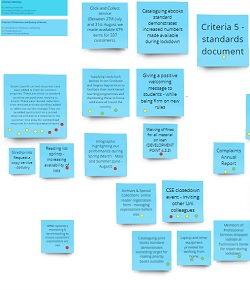How can you gain consensus within a group quickly?
Picture the scene. Everyone knows that there are many issues to be addressed and everyone has a slightly different take on what needs to be done. How can we progress our continuous improvement efforts?
One great tool that can help is, what I call, “Key Issue Identification”. The main purpose of this technique is to get a group consensus on what the key issues are that need to be addressed to overcome some sort of performance issue.
This technique can work equally well live in a room together, or in a virtual team environment.
In this blog I will focus on using this approach in a virtual environment because this has become the norm for many of us at the moment and will probably become part of how we work as we transition towards a new normal post-pandemic.
The approach works best with a group of about six to eight people with a facilitator.
It is good to plan the activity ahead of time and have a template already set up to capture digital sticky notes for the group’s inputs on a digital whiteboard such as Miro, Mural or Whiteboard.
What is it?
Key Issue Identification is a technique for getting consensus around the important issues that a group are facing using a lightning fast process. It is a great way to get people thinking about the current issues and challenges facing them in a very short space of time
Who should be involved?
Basically, anyone who has experience of the issue, and a vested interest in resolving the issue that you are currently looking at.
When should you use it?
This technique can be used at any time to drill down to the vital few issues that are affecting performance. It is a great way to get a list of common issues at the beginning of a particular continuous improvement initiative. It can also be used at an operational team level at any time to let people share their current concerns and issues within a particular area in a constructive way.
Why use it?
It is a fast and effective technique. You can very quickly help a group to get a lot of facts about a particular business issue and then drill down to the key areas that are affecting the group’s performance
Where to use it?
You can use the tool anywhere and can easily be used in a virtual environment such as Zoom or Teams
 How do you use it?
How do you use it?
There is a bit of preparation required to run a successful Key Issue Identification session that requires planning around the following ahead of time:
Platform
Have resources such as Zoom or Teams available in conjunction with a tool like Miro, Mural or Whiteboard. Create a whiteboard with blank digital sticky notes and also different coloured shapes to assist in voting (e.g. red circle, yellow circle, green circle)
People
The team should be typically made up of 5 to 8 people who are knowledgeable about the issue being reviewed.
It is always useful to have an experienced facilitator to lead the activity who is neutral to the process
Timing
This depends on the size of the issue being addressed and it can take anything from an hour, up to a full day depending on the level of detail you go into.
What are the steps in running a session?
Step 1: Agree the Area of Focus
The first step is to agree in the group the business issue that you want to explore together. and create an issue statement. The more precise you can be with the statement, the better you will find the process. Typically start by writing a statement on the digital white board focusing on a negative aspect of the business for example: “What is stopping us from …….”
Step 2: Generate Facts
You then ask each individual to write down as many facts about the statement as they can, adding one fact per digital sticky note. In the digital world it is a good idea to get individuals to type their initials on each note to ease identification.
You should explain to the group that we are looking for report writing vs affective writing when capturing their facts. For instance, affective writing would be “the applications are always poor”, whereas report writing would be “the last 3 sets of application forms received had a missing contact address”. We are always looking for facts to be written in a report manner. You can help people to do this by challenging “facts” that are not written in this way. Ideally, we are looking for at least 7 facts from each person.
Step 3: Review the Facts generated with the Group
Get each person in turn to read out their facts to the group to clarify understanding. This is an opportunity to challenge each fact and re-write where required.
As a group you should now have documented a fair number of facts about the issue being addressed that are randomly spread over the digital whiteboard.
Step 4: Arrange the Facts
This is the exciting bit and where the magic starts to happen. Ask the participants to group facts with a similar theme together, and to arrange them in clusters across the white board. Ask them to do this in silence. (Why in silence? Experience shows that if you are allowed to speak at this stage one or two individuals can dominate proceedings. Doing it silence gives a better grouping).
At the end of this stage you should end up with several groups of facts clustered together on the wall.
Step 5: Summarise the Clusters
The next step is to have a discussion and create a digital sticky note that summarises the essence of each cluster
Step 6 Voting on the Cluster summaries
In silence each person should vote for their top 3 issues as detailed on the summary digital sticky notes using the digital shapes I mentioned earlier (red circle = 3 points, yellow circle = 2 points, green circle = 1 point) Each person gets one of each coloured circle to vote.
Step 7 Summary of Voting
Once everyone has voted then we add up all the scores on the digital sticky notes (Usually there are two or three issues that come out as clear favourites. Don't get too hung up on the scores! This is a quick and dirty way of drilling down to the top few issues affecting performance.
Once completed, the cluster summary sticky note that the team feel is the biggest issue should end up with the biggest total score.
Step 8 Improvement Activity
Once the key issues are clear the team then need to capture and prioritise ideas to eliminate the top key issues identified.
In conclusion
This technique can help you understand the collective current issues very quickly.
It's a sound basis from which to make improvements. By using facts about a particular issue, it drills straight down to the key areas affecting performance and It gets the group to very quickly focus on a particular business issue.
If you are interested in finding out more about this technique, please get in touch with me.


